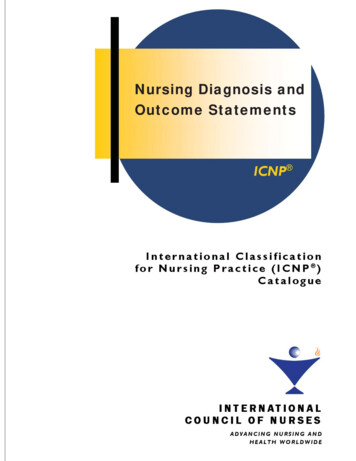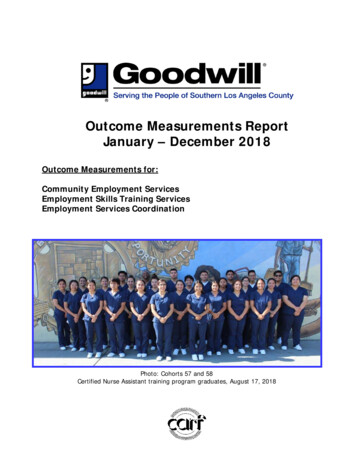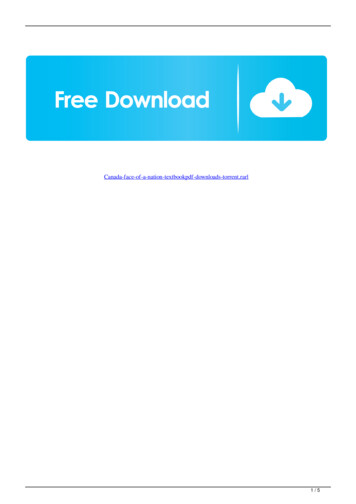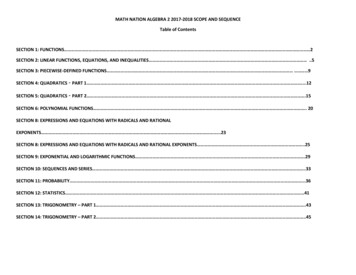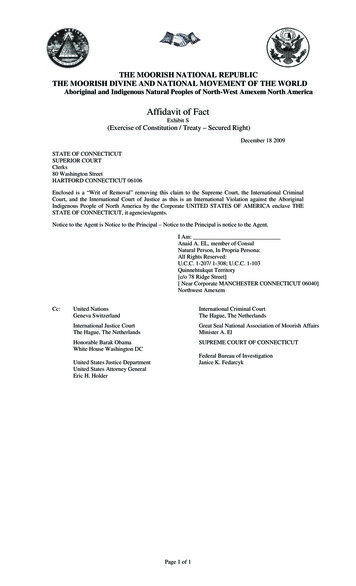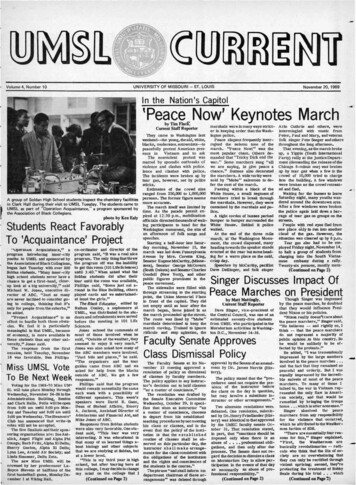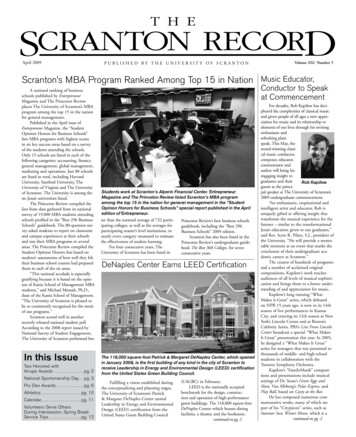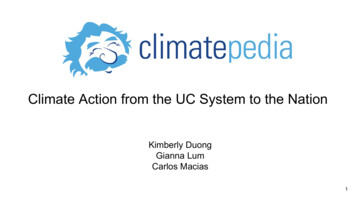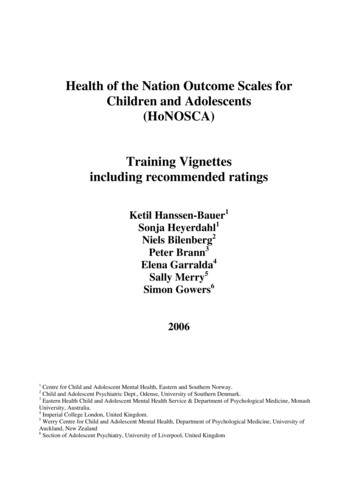
Transcription
Health of the Nation Outcome Scales forChildren and Adolescents(HoNOSCA)Training Vignettesincluding recommended ratingsKetil Hanssen-Bauer1Sonja Heyerdahl1Niels Bilenberg2Peter Brann3Elena Garralda4Sally Merry5Simon Gowers620061Centre for Child and Adolescent Mental Health, Eastern and Southern Norway.Child and Adolescent Psychiatric Dept., Odense, University of Southern Denmark.3Eastern Health Child and Adolescent Mental Health Service & Department of Psychological Medicine, MonashUniversity, Australia.4Imperial College London, United Kingdom.5Werry Centre for Child and Adolescent Mental Health, Department of Psychological Medicine, University ofAuckland, New Zealand6Section of Adolescent Psychiatry, University of Liverpool, United Kingdom2
A joint Australian,State and TerritoryGovernmentInitiative Commonwealth of Australia 2006This work is copyright. Apart from any use as permitted under the Copyright Act 1968, no partmay be reproduced by any process without prior written permission from the Commonwealthand the work can only be used for non-profit purposes. Requests and inquiries concerningreproduction and rights should be addressed to the Commonwealth Copyright Administration,Attorney General's Department, Robert Garran Offices, National Circuit, Canberra ACT 2600 orposted at http://www.ag.gov.au/ccaDisclaimerOpinions expressed in this publication are those of the authors and do not necessarily representany official Government position or view. The authors hold final editorial responsibility for thedocument and any errors that remain herein.The vignettes developed by the Centre for Child and Adolescent Mental Health, Eastern andSouthern Norway and Ketil Hanssen-Bauer are copyright (Centre for Child and AdolescentMental Health, Eastern and Southern Norway and Ketil Hanssen-Bauer, 2006) and are used bypermission. No part may be reproduced by any process without prior written permission from theCentre for Child and Adolescent Mental Health, Eastern and Southern Norway and KetilHanssen-Bauer, Norway and the work can only be used for non-profit purposes.2
CONTENTSBackground . 4Uses . 4Acknowledgements . 4Vignette 1: Maria, 9 years. 6Vignette 2: Helena, 11 years . 9Vignette 3: Iris, 14 years . 12Vignette 4: Catherine, 16 years. 15Vignette 5: Ingrid, 7 years. 18Vignette 6: John, 5 years. 21Vignette 7: Sylvia 17 years . 24Vignette 8: Henry, 7 years . 27Vignette 9: Sandy, 4 years . 30Vignette 10: Steven, 15 years. 33Vignette 11: Christian, 17 years. 36Vignette 12: Caroline, 12 years. 39Vignette 13: Valerie, 5 years. 42Vignette 14: Alexander, 13 years. 45Vignette 15: Julia 8 years. 48Vignette 16: Camilla, 13 years. 51Vignette 17: Daniel, 10 years. 54Vignette 18: Justin, 8 years . 57Vignette 19: Christine, 15 years. 60Vignette 20: Marcus, 6 years . 633
BackgroundThese vignettes were first constructed at the Centre for Child and Adolescent Mental Health,Eastern and Southern Norway as part of a project to investigate the inter-rater reliability ofHoNOSCA, CGAS, and the GAPD when used by clinicians in child and adolescent mentalhealth services (CAMHS). The case vignettes were based on anonymous clinical descriptionsfrom experienced clinicians working in CAMHS in different countries. We changed thedescriptions further in order to include symptoms and problems from different main parts ofDSM-IV and ICD-10 (chapter V) with an approximately normal distribution of severitymeasured by CGAS in the clinical range. The resulting vignettes are all constructed stories andnone are real people. It is also worth noting that these vignettes are on average more severe thancases from studies of outpatients. We included a wide range of problems and symptoms in arestricted number of cases.As part of this project we studied cross-national differences in the use of these instruments. Wetranslated the case vignettes, according to generally accepted procedures, from Norwegian toEnglish and Danish. Thirty clinicians from five different countries (Norway, England, Denmark,Australia and New Zealand) independently scored the vignettes. From each country there weresix raters. Afterwards each national group met and discussed the discrepancies in scores, andagreed upon a national consensus. We (the authors) then compared our national scores anddiscussed the discrepancies until we could arrive at a cross-national consensus represented by therecommended ratings given here.Agreement about assessment in mental health is always challenging. Results from the crossnational study will be published separately. One of the important benefits of these vignettes inour consensus discussions was that they helped to make overt the different assumptions andworking knowledge that sometimes contributed to different ratings.UsesThese case vignettes can be used as training materials for clinicians who are going to use theHealth of the Nation Outcome Scales for Children and Adolescents (HoNOSCA)1. They are alsosuitable for training in the Children’s Global Assessment Scale (CGAS)2 and the GlobalAssessment of Psychosocial Disabilities (GAPD)3. Our recommended scores are presented alongwith rationales and clarifications as required. The vignettes should be used together with thescoring instructions for the HoNOSCA, CGAS and GAPD including the glossaries andrecommended anchor points as appropriate.AcknowledgementsThanks to all clinicians who contributed with anonymous clinical descriptions.We would also like to thank the other raters from each country who not only evaluated andscored all the 20 case vignettes, but also met and discussed their discrepancies afterwards – ademanding exercise taking hours! The national group members in addition to ourselves were:1Gowers, S. G., Harrington, R. C., Whitton, A., et al (1999) Health of the Nation Outcome Scales for Children andAdolescents (HoNOSCA). Glossary for HoNOSCA score sheet. Br.J.Psychiatry, 174, 428-431.2Shaffer, D., Gould, M. S., Brasie, J., et al (1983) A Children's global assessment scale (CGAS). Arch GenPsychiatry, 40, 1228-1231.3World Health Organization (1996) Multiaxial classification of child and adolescent psychiatric disorders.4
Benedicte Skirbekk, Per-Erik Davidsen, Torunn Nøvik, Berit Grøholt from Norway; CraigJohnston, Peter Roots, Tim Hughes, Su Sukumaran from England; Torben Isager, JensBuchhave, Michael Maagensen, Kirsten Hørder, Flemming Warborg Larsen from Denmark;Jenny Hoffman, Margaret Jones, Merrie Carling, Tim Coombs, Peter Birleson from Australia;Heather McDowell, Epenesa Olo-Whaanga, Tania Cargo, Sarah Laing, Sue Treanor, AndrewParkin and Andrew Malone from New Zealand.The rating rationales were penned by Tim Coombs and Peter Brann based upon the author’sdiscussions.5
Vignette 1: Maria, 9 yearsMaria is referred to the outpatient clinic due to obsessive-compulsive symptoms.Symptoms and behavioural problemsDuring the past month there has been an increase in extensive obsessive-compulsive symptoms.She frequently washes her hands, many times a day, each time for approximately 10 minutes.She says she gets scared if she does not wash. If someone touches her, she feels she immediatelyhas to wash the area they have been in contact with or she has to change clothes. It is obviousthat she avoids touching things and others touching her. The symptoms vary. Sometimes they areout of control and she demands her parents take into consideration that she must not get dirty,has to change clothes, or that she is unable to finish washing when they are leaving forsomewhere. She has said that her need to wash so much is difficult for her and that shesometimes feels sad, although this passes quickly. She can become very irritated and stressed ifunable to wash herself.Her mother says that she has always been a social and active child who has enjoyed playingoutdoors. However, she now stays at home more than previously. There are no problems withrestlessness. Her concentration at school is good. At home she sometimes gets so angry that shescreams, but not in such a manner that the parents consider it a problem. She sleeps well.Social problemsLately Maria’s contact with friends has been reduced. She now only has one friend who shespends a bit of time with. She has not missed school, but often walks alone in the schoolyard andquite often turns to adults. She sings in a choir and plays the violin and this is still going fairlywell. She has a sister who is two years her junior whom she enjoys being with.Both parents have demanding positions. They are resourceful and their relationship is good.They also have many friends and a large family they spend a lot of time with.Developmental disorders and somatic problemsMaria’s psychomotor and language development has been normal. There have been noparticular physical diseases of note. The school report that she is doing well academically, butlately her performance has dropped somewhat and the teacher has raised this with her parents.Lack of information and knowledgeDuring the past two weeks her parents have spoken to many people regarding what Maria’sproblem could be, and they believe she is suffering from an obsessive-compulsive disorder. Herfather had obsessive-compulsive symptoms for a period during high school. He receivedsuccessful treatment for his problems. Consequently, they wonder whether a training programfor Maria might be an option and perhaps also medication despite her young age. They also wishto attend family consultations so all four of them can receive help to talk about what ishappening.6
Recommended ratings for Vignette 1, Maria 9 years:ItemBrief descriptionRating1Problems withDisruptive,Antisocial, orAggressiveBehaviourProblems withOveractivity,Attention, orConcentrationNon–accidentalSelf-injuryProblems withAlcohol,Substance orSolvent MisuseProblems withScholastic orLanguage Skills123456789Physical Illness orDisabilityProblemsassociated withHallucinations,Delusions, orAbnormalPerceptionsProblems withNon-organicSomaticSymptomsProblems withEmotional andRelatedSymptoms0RationaleThe consensus rating is for a sub clinical problem.Maria displays aggressive behaviour and she canbecome very irritated. At home she sometimes getsso angry that she screams, but not in such a mannerthat the parents consider it a problem.No indication of Overactivity, Attention orConcentration problems. Her concentration isconsidered good and she is not restless.0No indication of Non-accidental Self-injury.0No indication of Alcohol, Substance or SolventMisuse.2Maria’s recent deterioration in school performancewarrants a mild rating. Although not marked it issignificant enough for teachers to raise the issue withher parents. This would be sufficient to warrantclinical attention although the fact that it has only‘dropped somewhat’ indicates that a more severerating is not necessary.No indication of Physical Illness or Disabilityproblems.Maria believes that she must change or wash iftouched. While the vignette does not say thisexplicitly, the rating of 3 here occurs as there appearsto be a clear cognitive element to this presentation.That is, Maria appears to believe that something badwill happen if she does not engage in cleaning.Patients do not always make the connection betweenbehaviours, emotions and cognitions explicit.Whether her belief is seen as delusional or anovervalued idea, Maria is moderately preoccupiedwith this belief. Note that the fear she experienceswhen not washing are emotional symptoms and ratedat Scale 9.No reported Non-organic Somatic Symptoms.0303Maria gets scared if she does not wash. This fear andanxiety warrant a rating of 3. She also reportspassing sadness however as the anxiety is the moresevere symptom, the rating is informed by the anxietysurrounding the washing.7
ItemBrief description10Problems withPeerRelationships311Problems withSelf-care andIndependence212Problems withFamily Life andRelationshipsPoor SchoolAttendance013Rating0TOTAL SCORE14Problems withknowledge orunderstandingabout the natureof the child oradolescent’sdifficulties (in theprevious twoweeks)Problems with lackof informationabout services ormanagement ofthe child oradolescent’sdifficultiesRationaleWith only one friend, and the reduction of contactwith other friends, Maria has developed moderateproblems with her peers. She is not severely socialisolated as she still has a friend with whom shespends time.While it is easy to see this scale as focussing purelyon deficits in Self-care and Independence, the ratersbelieve that problems may also occur in self-care dueto excess. In Maria’s situation, her excessivecleaning and washing represent a definite problem inself-care. Her inability to stop washing interfereswith her ability to get herself ready for otheractivities and it is this impaired organisational abilitythat informed this rating.No problems with Family Life and Relationships.No problems with Poor School Attendance as therehas been no absenteeism.140No problems with lack of knowledge – nature ofdifficulties. Perhaps as a result of the fathers pastexperience, the parents have an understanding ofobsessive-compulsive disorder and associateddifficulties.0The family are speculating on appropriatemanagement approaches and display no problems.CGAS (Children’s GlobalAssessment Scale)49GAPD (GlobalAssessment ofPsychosocial Disabilities)3Maria’s worries cause a moderate degree ofinterference in functioning at home and with friendsand mild interference in functioning at school.Maria’s functioning is moderately disabled in peerand self-care domains.158
Vignette 2: Helena, 11 yearsHelena is referred from the department of paediatrics at the hospital due to fatigue, pain,dizziness and sadness.Symptoms and behavioural problemsDuring the past three months Helena has been increasingly tired and has complained of bodilypains, particularly in the stomach, the neck and head and she has felt very dizzy. She has beenadmitted to the hospital for the past three weeks and has been thoroughly assessed, withoutfindings that could explain her symptoms. She can barely sit upright in a wheelchair. She and herparents are certain she is suffering from an undiscovered serious illness that is causing thesesymptoms. She says she feels sad all of the time and never has a happy moment. She has had nosuicidal thoughts. She wishes she was not so worn out and that she did not have so much pain.There has been no overt aggression. Her concentration is severely reduced; she cannot read, andcan only watch TV for a maximum of five minutes before she is forced to stop because she getsso tired.Social problemsSchoolmates frequently visit Helena at the hospital and there is much talk of her illness at school.She cannot care for herself at all, but must be fully assisted in her bed or in the wheelchair. Shecan barely lift her arms. She has great difficulty swallowing and must be fed with liquidnourishment. She must be helped to the toilet. Her mother has stayed with Helena the entire timethrough the three weeks of the admission and she is completely exhausted. The parents say thatthey otherwise have a good family life. She has an older sister. Helena has been unable to receiveany tutoring the past three weeks whatsoever. Contact with the hospital school has beenestablished, but lessons have not started yet.Developmental disorders and somatic problemsNormal development, previously healthy, good school performance and active in sports.Lack of information and knowledgeHelena’s parents are in complete disagreement with the doctors at the unit who claim thesymptoms are psychologically grounded. There have been conflicts between the parents and thestaff, particularly the doctors on this matter. The parents are of the opinion that the treatmentprogram with physiotherapy and active training, which the doctors have initiated, is directlyharmful.9
Recommended ratings for Vignette 2, Helena 11 years:ItemBrief descriptionRating1Problems withDisruptive,Antisocial, orAggressiveBehaviourProblems withOveractivity,Attention, orConcentrationNon–accidentalSelf-injuryProblems withAlcohol,Substance orSolvent MisuseProblems withScholastic orLanguage Skills0No problems with Disruptive, Antisocial, orAggressive Behaviour.4Helena has severely reduced concentration; shecannot read and is only able to watch TV for fiveminutes.0No problems with Non-accidental Self-injury.0No problems with Alcohol, Substance or SolventMisuse.4While there is no explicit information in the vignette,the score of 4 is based on the presumption that fromthe total description, Helena’s overall functioning andsymptoms are such that it is inconceivable that therehas not been a severe impairment in her scholasticperformance. She is totally exhausted, unable toconcentrate, has had no tutoring over the past weeks,has not yet attended the hospital school and theseaspects (rated elsewhere) led the raters to concludethat a severe drop in scholastic performance wasmore likely than not.No indication of Physical Illness or Disabilityproblems.This rating was discussed intensely by the raters. Thescore of 3 is based on the view that her expressedbelief that she is suffering from an “undiscoveredserious illness” is in the absence of any confirmationfrom the paediatric department. That the paediatricdepartment referred her was taken to indicate thatthorough investigations had occurred. This is seenas an overvalued or unshakable belief which ispreoccupying and a moderate problem. It isimportant to note that, as with all psychiatricinvestigat
Health of the Nation Outcome Scales for Children and Adolescents (HoNOSCA) Training Vignettes including recommended ratings Ketil Hanssen-Bauer1 Sonja Heyerdahl1 Niels Bilenberg2 Pet
